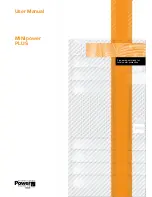
Operations Manual | 5
Battery Safety
English
This battery must be installed by qualified personnel in accordance with the latest edition of the National
Electrical Code ANSI/NFPA 70 and/or Canadian Electrical Code, Part I, CSA C22.1.
To prevent accidental shorts, shocks or electrocutions, never let water or any form of liquid touch, surround or
enter the batteries.
Do not operate the batteries with damaged cables and wires. Defective cables and wires must be replaced
before system installation. Prior to system installation, verify that all cables and wires are properly secured and
connected. Faulty connections can interrupt operation and cause irreparable damage to this product.
Opening or attempting to dismantle the battery case will void the warranty and create a risk of electrical
short circuit, burns or other physical harm
Do not dispose of batteries in a fire. The batteries may explode.
Do not open or mutilate batteries. Released electrolyte is harmful to the skin and eyes. It may be toxic.
A battery can present a risk of electrical shock and high short-circuit current. Contact with any part of a
grounded battery can result in electrical shock. The following precautions should be observed
when working on batteries:
a. Remove watches, rings, or other metal objects.
b. Use tools with insulated handles.
c. Wear rubber gloves and boots.
d. Do not lay tools or metal parts on top of batteries.
e. Disconnect charging source and load prior to installing or maintaining the battery.
f. Remove battery grounds during installation and maintenance to reduce likelihood of shock.
g. Remove the connection from ground if any part of the battery is determined to be grounded.
Note: Reference the Z5 13-80 H S F Safety Data Sheet for additional battery safety instructions.
https://www.zincfive.com/subc-prismatic-material-safety-data-sheet
French
Cette batterie doit être installée dans les applications d’utilisation fin par un personnel qualifié dans l’utilisa-
tion sécuritaire des alimentations à haute énergie et de leurs batteries. La connaissance du code électrique
local et de leur application sécuritaire est également suppose.
Pour éviter les shorts, chocs ou électrocutions accidentels, ne laissez jamais l’eau ou toute autre forme de
toucher liquide, entourer ou entrer dans les batteries.
Ne pas faire fonctionner les batteries avec des câbles et des fils endommagés. Les câbles et les fils défectueux
doivent être remplacés avant l’installation du système. Avant l’installation du système, vérifiez que tous les
câbles et fils sont correctement fixés et connectés. Les connexions défectueuses peuvent interrompre le
fonctionnement et causer des dommages irréparables à ce produit.
Le démantèlement ou l’ouverture de l’enceinte de la batterie annulera la garantie du produit et créera un
risque de choc électrique.






































